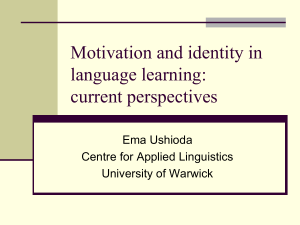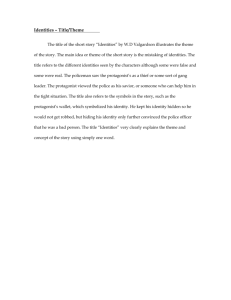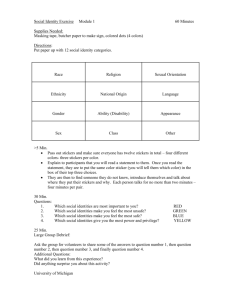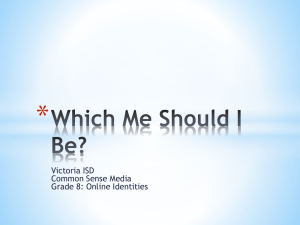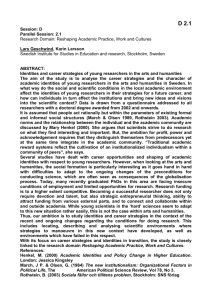L2 motivation, self and identity: Current theoretical perspectives
advertisement
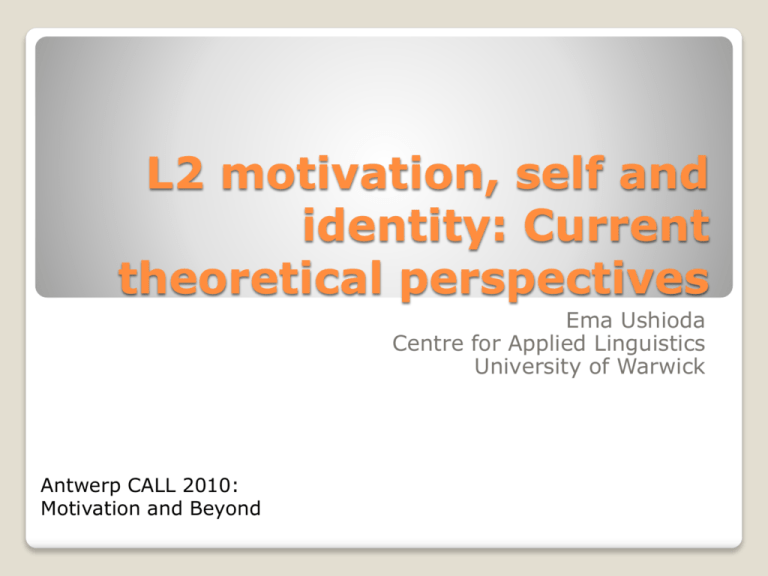
L2 motivation, self and identity: Current theoretical perspectives Ema Ushioda Centre for Applied Linguistics University of Warwick Antwerp CALL 2010: Motivation and Beyond My early background in CALL Email tandem language learning bilateral project in late 1990s (Ushioda 2000; Ushioda et al. 1999) Connecting students in Ireland (Trinity College Dublin) and Germany (Ruhr-Universität Bochum) A ‘successful’ tandem partnership more than just ‘L2 learner’ identities Overview of my talk Traditional concepts of L2 motivation (integrative motivation) Re-theorizing L2 motivation in relation to self and identity Implications for classroom practice Implications for exploiting digital technologies Traditional L2 motivation concepts Instrumental and integrative L2 motivation L1 community, culture and values L2 learner TL community, culture and values Gardner & Lambert 1959, 1972 From external to internal processes of identification global Internet community global community of English users Reconceptualizing integrativeness as an internal process of identification within the self-concept (Dörnyei & Csizér 2002) me Motivation and possible selves Theory of possible selves (Markus & Nurius 1986) Future self-guides which channel motivation Self-discrepancy theory (Higgins 1987) Psychological desire to reduce discrepancy between current and ideal self L2 Motivational Self System Dörnyei 2005, 2009 Ideal L2 Self Ought-to L2 Self Empirical research: •Csizér & Kormos 2009 •Ryan 2009 •Taguchi et al. 2009 L2 Learning Experience Concepts of identity Identity as major issue in applied linguistics • e.g. Block 2007; Lin 2007 Identity-oriented theories of motivation in educational psychology • Educational Psychologist 44(2), edited by Kaplan & Flum 2009 Ethnolinguistic identity • intergroup model (Giles & Byrne 1982) in theories of SLA and • situated identity theory (Clément & Noels second language 1992) communication L2 motivation and current concepts of identity Pursuit of global, bicultural or multicultural identities • Lamb 2004, 2009 Aspirations towards desired social or professional identities in imagined L2 communities • Kanno & Norton 2003 • Norton 2001 Identities as ways of relating the self to the social world • van Lier 2007 Identities personally valued constructions Norton 2000, 2001; Menard-Warwick 2009 socially forged and negotiated can be contested, resisted, denied Linking identity perspectives with possible future selves • constantly constructed, negotiated and reconstructed current identities identity goals • evolving experiences, relations and identities • long-term personal motivational trajectories possible future selves Linking present L2 experience to future imagined L2 experience Engaging students’ current social identities in their L2 interactions Enables them to engage directly with possible future selves as L2 users Motivating the person rather than the L2 learner Language as medium of self-expression, giving ourselves voice and identity Language learners as ‘people’, with uniquely individual personalities, histories, identities (Ushioda 2009) L2 motivation theory to date – focus on abstract models and learner types, not people Motivating the person: Looking beyond L2 motivation literature Learner-centred teaching Personalisation and authentic communication Humanistic approaches Classroom management and dynamics Learner autonomy in language education Dogme language teaching Dogme movement in ELT Thornbury 2000; Meddings & Thornbury 2009 Inspiration from minimalist-style Danish cinematic movement in 1995 (Dogme 95) Primary focus on conversational interaction among teacher and students Authentic communication, driven by students’ own interests and agendas Value of students’ personal voices and identities Motivational importance of orienting to students’ preferred identities situated identities discourse identities • doctor/patient • speaker/audience • teacher/student • initiator • listener • questioner Richards 2006: Analysis of classroom talk, based on Zimmerman’s (1998) model of discoursal and social identities transportable identities • mother of two • keen tennis player • science fiction fan Engaging students’ transportable identities in the digital age Dogme ‘vow of chastity’ or ‘teaching unplugged’ and technology-free (Meddings & Thornbury 2009) But … Web 2.0 …‘Dogme 2.0’ (Vickers 2009) Students’ transportable identities grounded not just in physical but also virtual worlds – cyberspace, blogosphere, social networking, mobile communication technologies Students as ‘digital natives’ (Prensky 2001) Fusion of personal technology use inside and outside L2 classroom Web 2.0 Personal interests and needs Communication, collaboration, participation Individual and creative identities Everyday technologies and resources Developing L2 skills using same technologies and resources to pursue own needs and interests To conclude … a shift in identity roles Students as technology ‘experts’ cf. Ushioda et al. in press Teacher as ‘learner’ Reshaping students’ psychological relation to content and process of learning, as they assume greater autonomy (Little 1991) and greater internally regulated motivation (Ushioda 2003) From new situated identities potential for developing new possible future L2 selves

